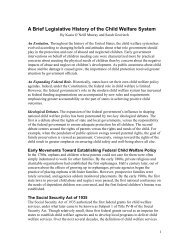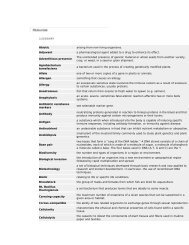Protecting Western Australia's Big Blue Backyard - The Pew ...
Protecting Western Australia's Big Blue Backyard - The Pew ...
Protecting Western Australia's Big Blue Backyard - The Pew ...
You also want an ePaper? Increase the reach of your titles
YUMPU automatically turns print PDFs into web optimized ePapers that Google loves.
THE HOUTMAN HOTSPOT FOR MARINE LIFE<br />
Lying in the Leeuwin Current’s path, bathed in its<br />
warm tropical waters, are the globally significant<br />
Houtman-Abrolhos Islands.<br />
It was Dutch sea captain Frederik de Houtman who<br />
so modestly named the Houtman-Abrolhos Islands<br />
in 1619. This glittering archipelago of 122 islands<br />
lies 70 kilometres off the Geraldton coast.<br />
Ten years after Houtman’s visit, the islands became<br />
the scene of human tragedy with the wreck of the<br />
Dutch East India Company’s treasure-laden ship<br />
the Batavia. It is a dark and infamous story, one of<br />
mutiny, murder and mayhem among the survivors<br />
as they waited nine months for rescue.<br />
<strong>The</strong> wreck of the Batavia is also well known for what<br />
it revealed about the early exploration and use of<br />
Australia’s oceans by the Dutch, well before the<br />
arrival of French and English explorers. After the<br />
wreck’s discovery in the 1960s, Australian history<br />
had to be rewritten.<br />
<strong>The</strong> Batavia’s hapless survivors, who would have<br />
made extensive use of marine life on and around<br />
the islands, could never have known of its global<br />
significance.<br />
As warm waters flow among the Houtman-<br />
Abrolhos Islands, the larvae, eggs and polyps of<br />
tropical species settle on the fringing coral reefs.<br />
Thanks to the Leeuwin Current, which keeps the<br />
waters warmer than they would otherwise be,<br />
this is the most southerly location for tropical<br />
reef-building coral in the entire Indian Ocean.<br />
<strong>The</strong> tropical marine life brought to the islands,<br />
reefs and lagoons mixes with subtropical and<br />
temperate algae, fish and invertebrates.<br />
<strong>The</strong>re are more than 400 species of fish and at<br />
least 184 species of coral, 492 of mollusc, 110 of<br />
sponge, 172 of echinoderm such as seastars and<br />
sea cucumbers, and 234 of benthic algae<br />
(which include seaweeds).<br />
With an abundance of small surface-dwelling fish in<br />
the surrounding shallow waters forming tantalising<br />
‘bait balls’, the islands are internationally important<br />
breeding colonies for seabirds including the<br />
sooty tern and bridled tern. Nowadays more than<br />
one million pairs of wedge-tailed shearwaters<br />
and 68,000 pairs of the threatened lesser noddy<br />
live and breed here—the only known Australian<br />
breeding site for this species.<br />
But the significance of these remarkable bird<br />
colonies was not always recognised. On islands<br />
like Rat Island, the guano formed by the build up<br />
of the birds’ droppings was mined from the 1890s<br />
for use as fertiliser on <strong>Western</strong> Australian farms.<br />
Before mining began an estimated 1.5 million<br />
brown noddy and sooty terns lived on the islands.<br />
By the time mining ended in the 1940s, and after<br />
egg collectors, rats and cats had taken their toll,<br />
the brown noddies and sooty terns were gone.<br />
Fortunately, the sooty terns have returned to the<br />
Houtman-Abrolhos Islands and are now extending<br />
their range south. Along with bridled terns, roseate<br />
terns and brown noddies, they have settled on<br />
Lancelin Island, the most southerly point for any<br />
of their colonies. <strong>The</strong> extension to their range<br />
could be connected to a southerly shift by their<br />
food fish as the region’s waters warm with climate<br />
change. No-take marine reserves can provide vital<br />
protection for the food species needed by<br />
these birds.<br />
<strong>The</strong> Houtman-Abrolhos Islands are a hotspot for<br />
marine life and this has made them an increasingly<br />
popular destination for ecotourists, recreational<br />
fishers and divers—20 of Australia’s 132 dive<br />
wrecks are found here. Unfortunately, greater<br />
pressure on fish stocks, and damage to delicate<br />
corals from fishing gear and anchors, are some<br />
of the results of this growing interest.<br />
THE LEEUWIN, LARVAE AND LOBSTERS<br />
Before leaving the Houtman-Abrolhos Islands,<br />
the Leeuwin Current plays a pivotal role in the<br />
life cycle of the western rock lobster, which is<br />
only found off <strong>Western</strong> Australia. <strong>The</strong> region’s<br />
western rock lobster fishery is Australia’s most<br />
lucrative fishery.<br />
When lobster larvae emerge from their mother’s<br />
eggs, they spend ten months drifting as plankton<br />
offshore. Those that avoid being eaten by small<br />
fish turn into puerulus, which is the life stage<br />
when they begin to look like lobsters. Westerly<br />
winds help the puerulus drift inshore where they<br />
settle on shallow reefs and among seagrass<br />
meadows nurtured by the clear warm waters<br />
of the Leeuwin Current.<br />
When the Leeuwin Current is strong, water<br />
temperatures are higher and a greater number<br />
of puerulus are able to survive. More settle,<br />
grow up as rock lobsters and then move en masse<br />
to deeper water four years later. <strong>The</strong> current<br />
also carries rock lobster larvae from the<br />
Houtman-Abrolhos Islands to southern waters<br />
where they make up half of the puerulus<br />
settlement each year.<br />
<strong>The</strong> life of a western rock lobster is critical to<br />
many other lives in the region’s marine waters.<br />
As it grows, so too does the size of its predators.<br />
Lobster larvae are food for small pelagic fish.<br />
At the puerulus stage it is eaten by wrasse or<br />
trumpeter, and as an adult a rock lobster is on the<br />
menu for seals, baldchin groper, West Australian<br />
dhufish, octopuses and wobbegongs. <strong>The</strong> lobster<br />
is a voracious predator in its own right, feeding on<br />
snails, crabs and urchins.<br />
For the past two years there have been very low<br />
numbers of puerulus settling in the shallows along<br />
the region’s west coast. <strong>The</strong>re are concerns this<br />
could mean many fewer lobsters reach adulthood,<br />
further worsening recent poor catches.<br />
<strong>The</strong> variable strengths of the Leeuwin Current<br />
also lead to ups and downs in the commercial<br />
catches for other species such as prawns, scallops,<br />
Australian salmon, herring, pink snapper, whitebait<br />
and tailor. <strong>The</strong> links between the Leeuwin Current<br />
and these commercially significant species are yet<br />
to be fully understood.<br />
Scientists from the Commonwealth Scientific and<br />
Industrial Research Organisation (CSIRO) recently<br />
suggested that climate change could weaken<br />
the Leeuwin Current and lead to cooler water<br />
temperatures in the region. This could, however,<br />
be offset by the rising water temperatures<br />
generally associated with climate change. With<br />
water temperatures influencing the distribution<br />
and productivity of many marine species, any<br />
long-term increases or decreases within the region<br />
could have significant implications for the region’s<br />
marine life.<br />
<strong>Western</strong> rock lobsters, found only<br />
in <strong>Western</strong> Australian waters,<br />
underpin Australia’s most lucrative<br />
fishery, but commercial catches are<br />
now in decline<br />
© marinethemes.com / Clay Bryce<br />
27
















